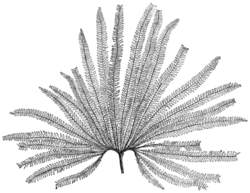Biology:Matoniaceae
| Matoniaceae | |
|---|---|

| |
| Matonia pectinata | |
| Scientific classification | |
| Kingdom: | Plantae |
| Clade: | Tracheophytes |
| Division: | Polypodiophyta |
| Class: | Polypodiopsida |
| Order: | Gleicheniales |
| Family: | Matoniaceae C.Presl 1847 |
| Genera | |
| |
Matoniaceae is one of the three families of ferns in the Gleicheniales order of the Polypodiopsida class.[1][2] Fossil records reveal that Matoniaceae ferns were abundant during the Mesozoic era (about 250-million to 66-million years ago), during which they lived on every continent, including Antarctica, with eight genera and 26 species, with the oldest known specimens being from the Middle Triassic of Antarctica.[3] Today the family is much less abundant, and also less diverse, with only two extant genera and four species,[4] which are limited to portions of southeastern Asia.[5]
The following diagram shows a likely phylogenic relationship with the other two families of the Gleicheniales.[6]
| Gleicheniales |
| |||||||||||||||||||||
Extant taxa
Mesozoic subtaxa

Some common Mesozoic Matoniaceae genera and a sampling of their species include:
- species Laccopteris elegans Presl 1838
- species Laccopteris münsteri Schenk 1867
- species Phlebopteris polypodioides Brongniart
- species Phlebopteris smithii
- species Phlebopteris woodwardii Leckenby 1864
- species Phlebopteris utensis
- species Phlebopteris angustiloba
- genus Template:Txil[7]
- species Matonia jeffersonii
- species Matonia pectinata
- species Matonia braunii
- species Matonia mesozoica
- species Matonia brownii
- genus Microdictyon
- Tomaniopteris Klavins et al. Fremouw Formation, Middle Triassic, Antarctica
- Konijnenburgia Kvaček et Dašková, 2010 Piedra Clavada Formation, Argentina, Albian
References
- ↑ Alan R. Smith; Kathleen M. Pryer; Eric Schuettpelz; Petra Korall; Harald Schneider; Paul G. Wolf (2006). "A classification for extant ferns". Taxon 55 (3): 705–731. doi:10.2307/25065646. http://www.pryerlab.net/publication/fichier749.pdf.
- ↑ Maarten J. M. Christenhusz, Xian-Chun Zhang & Harald Schneider (2011). "A linear sequence of extant families and genera of lycophytes and ferns". Phytotaxa 19: 7–54. doi:10.11646/phytotaxa.19.1.2. http://www.mapress.com/phytotaxa/content/2011/f/pt00019p054.pdf.
- ↑ Klavins, Sharon D.; Taylor, Thomas N.; Taylor, Edith L. (January 2004). "Matoniaceous Ferns (Gleicheniales) from the Middle Triassic of Antarctica". Journal of Paleontology 78 (1): 211–217. doi:10.1666/0022-3360(2004)078<0211:MFGFTM>2.0.CO;2. ISSN 0022-3360. https://bioone.org/journals/journal-of-paleontology/volume-78/issue-1/0022-3360(2004)0782.0.CO;2/MATONIACEOUS-FERNS-GLEICHENIALES-FROM-THE-MIDDLE-TRIASSIC-OF-ANTARCTICA/10.1666/0022-3360(2004)0782.0.CO;2.full.
- ↑ Christenhusz, M. J. M.; Byng, J. W. (2016). "The number of known plants species in the world and its annual increase". Phytotaxa (Magnolia Press) 261 (3): 201–217. doi:10.11646/phytotaxa.261.3.1. http://biotaxa.org/Phytotaxa/article/download/phytotaxa.261.3.1/20598.
- ↑ Robbin C. Moran (2004). A Natural History of Ferns. Timber Press, Portland & Cambridge. pp. 119–124.
- ↑ Samuli Lehtonen (2011). "Towards Resolving the Complete Fern Tree of Life". PLOS ONE 6 (10): e24851. doi:10.1371/journal.pone.0024851. PMID 22022365. PMC 3192703. Bibcode: 2011PLoSO...624851L. http://www.sci.utu.fi/sivustot/amazon/publications/articles/pdf_pub/Lehtonen_2011_PLoS1.pdf.
- ↑ Nagalingum & Cantrill: Early Cretaceous Gleicheniaceae and Matoniaceae (Gleicheniales) from Alexander Island, Antarctica Review of Palaeobotany and Palynology 138 (2006)
Wikidata ☰ Q2549255 entry
 |

